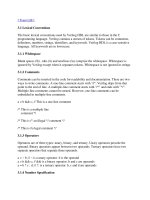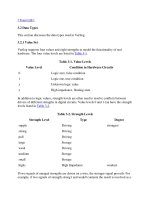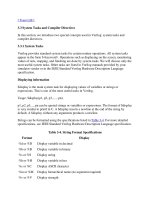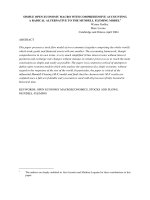31 open economy macroeconomics basic concepts
Bạn đang xem bản rút gọn của tài liệu. Xem và tải ngay bản đầy đủ của tài liệu tại đây (48.73 KB, 4 trang )
SOLUTIONS TO TEXT PROBLEMS:
Quick Quizzes
1. Net exports are the value of a nation’s exports minus the value of its imports,
also called the trade balance. Net capital outflow is the purchase of foreign
assets by domestic residents minus the purchase of domestic assets by
foreigners. Net exports equal net capital outflow.
2. The nominal exchange rate is the rate at which a person can trade the
currency of one country for the currency of another. The real exchange rate is
the rate at which a person can trade the goods and services of one country for
the goods and services of another. They are related through the expression:
real exchange rate equals nominal exchange rate times domestic price divided
by foreign price.
If the nominal exchange rate goes from 100 to 120 yen per dollar, the dollar
has appreciated because a dollar now buys more yen.
3. Because Mexico has had high inflation and Japan has had low inflation, the
number of Mexican pesos a person can buy with Japanese yen has increased.
Questions for Review
1. The net exports of a country are the value of its exports minus the value of its
imports. Net capital outflow refers to the purchase of foreign assets by
domestic residents minus the purchase of domestic assets by foreigners. Net
exports are equal to net capital outflow by an accounting identity, because
exports from one country to another are matched by payments of some asset
from the second country to the first.
2. Saving equals domestic investment plus net capital outflow, because any
dollar saved can be used to finance accumulation of domestic capital or it can
be used to finance the purchase of capital abroad.
3. If a dollar can buy 100 yen, the nominal exchange rate is 100 yen per dollar.
The real exchange rate equals the nominal exchange rate times the domestic
price divided by the foreign price, which equals 100 yen per dollar times
$10,000 per American car divided by 500,000 yen per Japanese car, which
equals two Japanese cars per American car.
4. The economic logic behind the theory of purchasing-power parity is that a
good must sell for the same price in all locations. Otherwise, people would
profit by engaging in arbitrage.
5. If the Fed started printing large quantities of U.S. dollars, the U.S. price level
would increase, and a dollar would buy fewer Japanese yen.
Problems and Applications
1. a. When an American art professor spends the summer touring museums in
Europe, he spends money buying foreign goods and services, so U.S.
exports are unchanged, imports increase, and net exports decrease.
b. When students in Paris flock to see the latest movie from Hollywood,
foreigners are buying a U.S. good, so U.S. exports rise, imports are
unchanged, and net exports increase.
c. When your uncle buys a new Volvo, an American is buying a foreign good,
so U.S. exports are unchanged, imports rise, and net exports decline.
d. When the student bookstore at Oxford University sells a pair of Levi's 501
jeans, foreigners are buying U.S. goods, so U.S. exports increase, imports
are unchanged, and net exports increase.
e. When a Canadian citizen shops in northern Vermont to avoid Canadian
sales taxes, a foreigner is buying U.S. goods, so U.S. exports increase,
imports are unchanged, and net exports increase.
2. a. When an American buys a Sony TV, there is a decrease in net exports.
b. When an American buys a share of Sony stock, there is an increase in net
capital outflow.
c. When the Sony pension fund buys a U.S. Treasury bond, there is a
decrease in net capital outflow.
d. When a worker at Sony buys some Georgia peaches from an American
farmer, there is an increase in net exports.
3. Foreign direct investment requires actively managing an investment, for
example, by opening a retail store in a foreign country. Foreign portfolio
investment is passive, for example, buying corporate stock in a retail chain in
a foreign country. As a result, a corporation is more likely to engage in foreign
direct investment, while an individual investor is more likely to engage in
foreign portfolio investment.
4. a. When an American cellular phone company establishes an office in the
Czech Republic, U.S. net capital outflow increases, because the U.S.
company makes a direct investment in capital in the foreign country.
b. When Harrod's of London sells stock to the General Electric pension fund,
U.S. net capital outflow increases, because the U.S. company makes a
portfolio investment in the foreign country.
c. When Honda expands its factory in Marysville, Ohio, U.S. net capital
outflow declines, because the foreign company makes a direct investment
in capital in the United States.
d. When a Fidelity mutual fund sells its Volkswagen stock to a French
investor, U.S. net capital outflow declines (if the French investor pays in
U.S. dollars), because the U.S. company is reducing its portfolio investment
in a foreign country.
5. a. The newspaper shows nominal exchange rates, because it shows the
number of units of one currency that can be exchanged for another
currency.
b. Many answers are possible. In October 2010, the nominal exchange rate
between the U.S. dollar and the Canadian dollar was 1 U.S. dollar = 1.0133
Canadian dollars. The nominal exchange rate between the U.S. dollar and
the Japanese yen was 1 U.S. dollar = 82 yen. Therefore, the exchange rate
between the Canadian dollar and the Japanese yen should be 1.0133
Canadian dollars = 82 yen. This implies that 1 Canadian dollar =
82/1.10133 yen = 80.92 yen.
c. If U.S. inflation exceeds Japanese inflation over the next year, you would
expect the dollar to depreciate relative to the Japanese yen because a
dollar would decline in value (in terms of the goods and services it can
buy) more than the yen would.
6. a. Dutch pension funds holding U.S. government bonds would be happy if the
U.S. dollar appreciated. They would then get more Dutch guilders for each
dollar they earned on their U.S. investment. In general, if you have an
investment in a foreign country, you are better off if that country's
currency appreciates.
b. U.S. manufacturing industries would be unhappy if the U.S. dollar
appreciated because their prices would be higher in terms of foreign
currencies, which will reduce their sales.
c. Australian tourists planning a trip to the United States would be unhappy if
the U.S. dollar appreciated because they would get fewer U.S. dollars for
each Australian dollar, so their vacation will be more expensive.
d. An American firm trying to purchase property overseas would be happy if
the U.S. dollar appreciated because it would get more units of the foreign
currency and could thus buy more property.
7. All the parts of this question can be answered by keeping in mind the
definition of the real exchange rate. The real exchange rate equals the
nominal exchange rate times the domestic price level divided by the foreign
price level.
a. If the U.S. nominal exchange rate is unchanged, but prices rise faster in
the United States than abroad, the real exchange rate rises.
b. If the U.S. nominal exchange rate is unchanged, but prices rise faster
abroad than in the United States, the real exchange rate declines.
c. If the U.S. nominal exchange rate declines and prices are unchanged in the
United States and abroad, the real exchange rate declines.
d. If the U.S. nominal exchange rate declines and prices rise faster abroad
than in the United States, the real exchange rate declines.
8. If purchasing-power parity holds, then 12 pesos per soda divided by $0.75 per
soda equals the exchange rate of 16 pesos per dollar. If prices in Mexico
doubled, the exchange rate will double to 32 pesos per dollar.
9. a. To make a profit, you would want to buy rice where it is cheap and sell it
where it is expensive. Because American rice costs 100 dollars per bushel,
and the exchange rate is 80 yen per dollar, American rice costs 100 × 80
equals 8,000 yen per bushel. So American rice at 8,000 yen per bushel is
cheaper than Japanese rice at 16,000 yen per bushel. So you could take
8,000 yen, exchange them for 100 dollars, buy a bushel of American rice,
then sell it in Japan for 16,000 yen, making a profit of 8,000 yen. As people
did this, the demand for American rice would rise, increasing the price in
America, and the supply of Japanese rice would rise, reducing the price in
Japan. The process would continue until the prices in the two countries
were the same.
b. If rice were the only commodity in the world, the real exchange rate
between the United States and Japan would start out too low, then rise as
people bought rice in America and sold it in Japan, until the real exchange
became one in long-run equilibrium.
10. If you take X units of foreign currency per Big Mac divided by 3.57 dollars per
Big Mac, you get X/3.57 units of the foreign currency per dollar; that is the
predicted exchange rate.
a. Chile: 1,750 pesos/3.57 = 490 pesos/$
Hungary: 720 forints/3.57 = 202 forints/$
Czech Republic: 67.9 korunas/3.57 = 19 korunas/$
Brazil: 8.03 reales/3.57 = 2.25 reales/$
Canada: 3.89C$/3.57 = 1.09C$/$
b. Under purchasing-power parity, the exchange rate of the Hungarian forint
to the Canadian dollar is 720 forints per Big Mac divided by 3.89 Canadian
dollars per Big Mac equals 185 forints per Canadian dollar. The actual
exchange rate is 199 forints per dollar divided by 1.16 Canadian dollars
per dollar equals 172 forints per Canadian dollar.
c. The exchange rate predicted by the Big Mac index (185 forints per
Canadian dollar) is somewhat close to the actual exchange rate of 172
forints per Canadian dollar.
11. a. The exchange rate is 1 Ecterian dollar is equal to 3 Wiknamian pesos.
b. In Ecteria, the price of Spam would double. The price level will quadruple in
Wiknam. The exchange rate between the two countries’ currencies would
double because of the differences in inflation rates.
effect.
c. Wiknam will have a higher nominal interest rate because of the Fisher
d. The get-rich scheme would only work if there were a difference in real
interest rates, not nominal interest rates. The nominal exchange rate
between the two countries will adjust for the effects of inflation.









